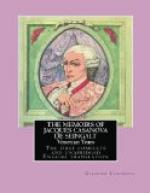‘They say that this Dux is a delightful spot,’ says Casanova in one of the most personal of his notes, ’and I see that it might be for many; but not for me, for what delights me in my old age is independent of the place which I inhabit. When I do not sleep I dream, and when I am tired of dreaming I blacken paper, then I read, and most often reject all that my pen has vomited.’ Here we see him blackening paper, on every occasion, and for every purpose. In one bundle I found an unfinished story about Roland, and some adventure with women in a cave; then a ’Meditation on arising from sleep, 19th May 1789’; then a ’Short Reflection of a Philosopher who finds himself thinking of procuring his own death. At Dux, on getting out of bed on 13th October 1793, day dedicated to St. Lucy, memorable in my too long life.’ A big budget, containing cryptograms, is headed ‘Grammatical Lottery’; and there is the title-page of a treatise on The Duplication of the Hexahedron, demonstrated geometrically to all the Universities and all the Academies of Europe.’ [See Charles Henry, Les Connaissances Mathimatiques de Casanova. Rome, 1883.] There are innumerable verses, French and Italian, in all stages, occasionally attaining the finality of these lines, which appear in half a dozen tentative forms:
’Sans mystere point de plaisirs,
Sans silence point de mystere.
Charme divin de mes loisirs,
Solitude! que tu mes chere!
Then there are a number of more or less complete manuscripts of some extent. There is the manuscript of the translation of Homer’s ’Iliad, in ottava rima (published in Venice, 1775-8); of the ‘Histoire de Venise,’ of the ‘Icosameron,’ a curious book published in 1787, purporting to be ‘translated from English,’ but really an original work of Casanova; ‘Philocalies sur les Sottises des Mortels,’ a long manuscript never published; the sketch and beginning of ’Le Pollmarque, ou la Calomnie demasquee par la presence d’esprit. Tragicomedie en trois actes, composed a Dux dans le mois de Juin de l’Annee, 1791,’ which recurs again under the form of the ’Polemoscope: La Lorgnette menteuse ou la Calomnie demasquge,’ acted before the Princess de Ligne, at her chateau at Teplitz, 1791. There is a treatise in Italian, ‘Delle Passioni’; there are long dialogues, such as ‘Le Philosophe et le Theologien’, and ‘Reve’: ‘Dieu-Moi’; there is the ‘Songe d’un Quart d’Heure’, divided into minutes; there is the very lengthy criticism of ’Bernardin de Saint-Pierre’; there is the ’Confutation d’une Censure indiscrate qu’on lit dans la Gazette de Iena, 19 Juin 1789’; with another large manuscript, unfortunately imperfect, first called ‘L’Insulte’, and then ‘Placet au Public’, dated ‘Dux, this 2nd March, 1790,’ referring to the same criticism on the ‘Icosameron’ and the ’Fuite des Prisons. L’Histoire de ma Fuite des Prisons de la Republique de Venise, qu’on appelle les Plombs’, which is the first draft of the most famous part of the Memoirs, was published at Leipzig in 1788; and, having read it in the Marcian Library at Venice, I am not surprised to learn from this indignant document that it was printed ’under the care of a young Swiss, who had the talent to commit a hundred faults of orthography.’




